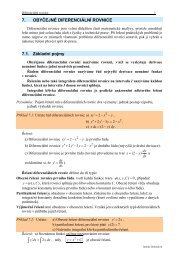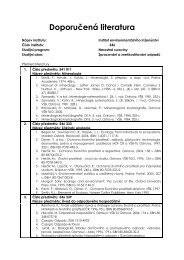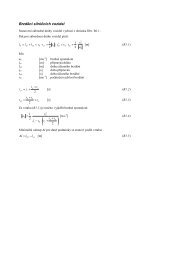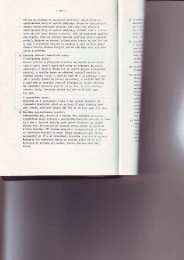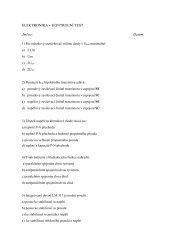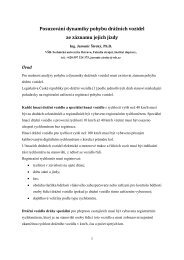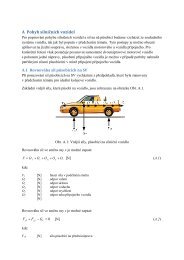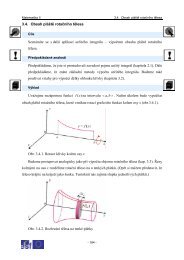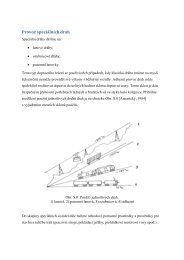fate of chlorine compounds in combustion of alternative fuels
fate of chlorine compounds in combustion of alternative fuels
fate of chlorine compounds in combustion of alternative fuels
Create successful ePaper yourself
Turn your PDF publications into a flip-book with our unique Google optimized e-Paper software.
FATE OF CHLORINE COMPOUNDS IN COMBUSTION OF ALTERNATIVE FUELSKamil WICHTERLE, Jan CIESLAR, Antonín KLEČKA, Zdeněk KLIKA and Václav ROUBÍČEKDepartment <strong>of</strong> Chemistry, VŠB TU Ostrava, 70833 Ostrava Poruba, Czech RepublicCorrespond<strong>in</strong>g author‘s e-mail: kamil.wichterle@vsb.cz(Received xxxx 2005, accepted xxxxxxxxx 2005)ABSTRACTMost <strong>of</strong> natural materials conta<strong>in</strong> traces <strong>of</strong> <strong>chlor<strong>in</strong>e</strong> and it enters also to the <strong>combustion</strong> process. Chlor<strong>in</strong>e products <strong>of</strong><strong>combustion</strong>s are usually <strong>in</strong>organic hydrogen chloride vapors and chloride salts, nevertheless smaller amount <strong>of</strong> organic<strong>chlor<strong>in</strong>e</strong> <strong>compounds</strong> are formed. Simpler <strong>of</strong> these organic <strong>compounds</strong> can act as greenhouse and ozone deplet<strong>in</strong>g gases;more complex <strong>compounds</strong> are directly dangerous for their mutagenity or extreme toxity like so called diox<strong>in</strong>es. Nonfossilnatural materials and <strong>fuels</strong> derived <strong>of</strong> them can conta<strong>in</strong> more <strong>chlor<strong>in</strong>e</strong> than common coal. From the publishedresearch studies is evident that the formation <strong>of</strong> organo<strong>chlor<strong>in</strong>e</strong> <strong>compounds</strong> is limited to the temperature range 300-800°C. At the higher temperatures, these <strong>compounds</strong> are destroyed. In the stage <strong>of</strong> flue gas cool<strong>in</strong>g some <strong>chlor<strong>in</strong>e</strong> maybe by a "de novo" synthesis <strong>in</strong>troduced to the organic form. Well-controlled <strong>combustion</strong> <strong>of</strong> <strong>alternative</strong> <strong>fuels</strong> need notcontribute to the <strong>in</strong>crease <strong>of</strong> amount <strong>of</strong> emissions <strong>of</strong> dangerous <strong>chlor<strong>in</strong>e</strong> <strong>compounds</strong>. In our research were moreoverstudied the <strong>fuels</strong> with lower <strong>chlor<strong>in</strong>e</strong> content. The experimental tests <strong>of</strong> the emissions from large-scale <strong>in</strong>dustrial fluidbed boiler <strong>in</strong>dicated that substitution <strong>of</strong> large percentage <strong>of</strong> coal by <strong>alternative</strong> <strong>fuels</strong> had no significant effect.KEYWORDS: <strong>chlor<strong>in</strong>e</strong>, diox<strong>in</strong>, <strong>combustion</strong>, <strong>alternative</strong> fuel1. INTRODUCTIONDemand to reduce the greenhouse gasproduction turns the attention to the substitution<strong>of</strong> fossil <strong>fuels</strong> by waste wood and agriculturalresidua, that were <strong>in</strong> past composted or not treatedanyhow. Various solid wastes from bioref<strong>in</strong>eries<strong>of</strong> food, pulp and paper production, textile fiber<strong>in</strong>dustries, organic sludge from wastewatertreatment can be employed as well. Highpercentage <strong>of</strong> combustibles is also conta<strong>in</strong>ed <strong>in</strong>solid mixed communal wastes and there aresimilar problems with employment <strong>of</strong> the relatedenergy.More and more effects <strong>of</strong> <strong>combustion</strong> to theenvironment have been systematically monitoredrecently. First, the attention was paid to thesmoke and flue ash. The smoke is no moreconsidered as a symbol <strong>of</strong> prosperity. Nextcontam<strong>in</strong>ants under exam<strong>in</strong>ation were sulfurdioxide and nitrogen oxides known as cause <strong>of</strong>acid ra<strong>in</strong>. Today, carbon dioxide and <strong>of</strong> otheressentially <strong>in</strong>ert components like volatile organic<strong>compounds</strong> and nitrous oxide, that can affect theozone layer and contribute to the greenhouseeffect are monitored. More attention is paid to them<strong>in</strong>or components like <strong>compounds</strong> <strong>of</strong> heavymetals and halogens, <strong>chlor<strong>in</strong>e</strong> <strong>in</strong> particular.The <strong>chlor<strong>in</strong>e</strong> <strong>compounds</strong> belong to the toxics,carc<strong>in</strong>ogenics, ozone deplet<strong>in</strong>g species. Therefore,prudence is necessary, when <strong>in</strong>troduc<strong>in</strong>g them tothe <strong>combustion</strong> process. In this paper, we arestudy<strong>in</strong>g the problem <strong>of</strong> <strong>chlor<strong>in</strong>e</strong> dur<strong>in</strong>g<strong>combustion</strong> <strong>of</strong> biomass and other <strong>alternative</strong> <strong>fuels</strong><strong>in</strong> <strong>in</strong>dustrial boilers. All lignocellulose materials –derived from wood, bark, straw, rice hulls,baggase, etc. conta<strong>in</strong> some <strong>chlor<strong>in</strong>e</strong>. Lowestpercentage is 0.1 % <strong>of</strong> Cl <strong>in</strong> dry matter <strong>of</strong>construction (cellulose) and storage (starch) parts,the specialized cells conta<strong>in</strong> up to 1 % Cl, higherpercentage can be detected <strong>in</strong> plants from sal<strong>in</strong>esoils. Dur<strong>in</strong>g the biomass <strong>combustion</strong>, this <strong>chlor<strong>in</strong>e</strong>enters number <strong>of</strong> chemical reactions produc<strong>in</strong>gproblematic <strong>compounds</strong>. As the amount <strong>of</strong> <strong>chlor<strong>in</strong>e</strong>fed can hardly be limited, it is necessary to controlthe process to m<strong>in</strong>imalize the non-demandedreactions.2. CHLORINE COMPOUNDS IN THE ENVIRONMENTThe <strong>chlor<strong>in</strong>e</strong> <strong>compounds</strong> on the Earth occurmostly as chemically stable and non-dangerouschlorides, either dissolved <strong>in</strong> oceans or stored <strong>in</strong>crystal form underground. However, lowconcentration <strong>chlor<strong>in</strong>e</strong> is scattered everywhere and itis irreplaceable for any liv<strong>in</strong>g organism. Also anatural chemical transformation <strong>of</strong> <strong>chlor<strong>in</strong>e</strong><strong>compounds</strong> and their movement is significant. Tocompare, the complete <strong>in</strong>dustrial production <strong>of</strong><strong>chlor<strong>in</strong>e</strong> is about 40 millions tons yearly. Onemedium size volcano eruption may evolve nearly onebillion tons <strong>of</strong> hydrogen chloride. Production <strong>of</strong>highly reactive elementary <strong>chlor<strong>in</strong>e</strong> byphotochemical reactions <strong>of</strong> chlorides at the sea levelis estimated to 800 millions tons per year.Chlor<strong>in</strong>e from the biological materials is releaseddur<strong>in</strong>g slow decomposition, dur<strong>in</strong>g natural fires anddur<strong>in</strong>g controlled <strong>combustion</strong>, preferably as<strong>in</strong>organic chloride <strong>compounds</strong>. In any case, smallfraction <strong>of</strong> organo-<strong>chlor<strong>in</strong>e</strong> <strong>compounds</strong> is formed,like methyl chloride (0.5 million tons/year),1
chlor<strong>of</strong>orm (0.7 million tons/year) and <strong>compounds</strong><strong>of</strong> the toxic group <strong>of</strong> diox<strong>in</strong>s PCDD/F (170kg/year).Industrial employment <strong>of</strong> <strong>chlor<strong>in</strong>e</strong> was oriented <strong>in</strong>19.century to the production <strong>of</strong> bleach<strong>in</strong>g powder,calcium hypochlorite, for bleach<strong>in</strong>g <strong>of</strong> textiles andpaper and for dis<strong>in</strong>fections. Water chlor<strong>in</strong>ation <strong>in</strong>towns started around 1900. Short episode withelementary <strong>chlor<strong>in</strong>e</strong> and organo-<strong>chlor<strong>in</strong>e</strong><strong>compounds</strong> as war gases lead to the development<strong>of</strong> efficient pesticides known as DDT, HCH, PCP,etc. Chlor<strong>in</strong>ated hydrocarbons became used assolvents, chloroprene res<strong>in</strong> and a wide scale <strong>of</strong>pharmaceutics was developed. Polychlor<strong>in</strong>atedbiphenyls (PCB), now forbidden as toxics, hadbeen excellent transformer oils. Chemical stabilityand simple liquefy<strong>in</strong>g <strong>of</strong> chlor-fluor<strong>in</strong>atedhydrocarbons (freons) was employed <strong>in</strong>refrigerators and <strong>in</strong> sprays. An <strong>in</strong>terest<strong>in</strong>g effect <strong>of</strong>halogenated hydrocarbons is fire <strong>in</strong>hibition andtheir use as fire retardants and fire ext<strong>in</strong>guish<strong>in</strong>gliquids. An important consumption <strong>of</strong> <strong>chlor<strong>in</strong>e</strong> is<strong>in</strong> manufacture <strong>of</strong> PVC, which is a still verypopular plastic with a wide application.Fast development at the beg<strong>in</strong>n<strong>in</strong>g <strong>of</strong> the 20 thcentury was accompanied with a low level <strong>of</strong>discipl<strong>in</strong>e at manufacture, transport, storage andapplication <strong>of</strong> chemicals, and little attention waspaid to the <strong>in</strong>dustrial emissions.One important turn<strong>in</strong>g po<strong>in</strong>t is dated 1976, when<strong>in</strong> Italian locality Seveso <strong>in</strong> a carelesslyabandoned reactor for production <strong>of</strong> 2,4,5-trochlorphenole (<strong>in</strong>termediate for dis<strong>in</strong>fectants)started uncontrolled spontaneous reaction and theaerosol cloud conta<strong>in</strong><strong>in</strong>g (Bluemler, 2005) 0.2 to 5kg <strong>of</strong> polychlor<strong>in</strong>ated diox<strong>in</strong>s escaped. Largeresidential area was evacuated and next 4 yearswere spent by the place decontam<strong>in</strong>ation. Thisaccident <strong>in</strong>itiated development <strong>of</strong> so called ECSeveso II Directive (EC, 1996), <strong>in</strong>ternationallyaccepted rules for prevention <strong>of</strong> <strong>in</strong>dustrialaccidents and limit<strong>in</strong>g <strong>of</strong> their eventualconsequences. It results <strong>in</strong>creas<strong>in</strong>g safety <strong>of</strong>chemical <strong>in</strong>dustry processes and alsomedialization <strong>of</strong> even banal cases <strong>of</strong> breakdownand spill.3. "DIOXINS"In the focus <strong>of</strong> our <strong>in</strong>terest is a group <strong>of</strong>persistent chlor<strong>in</strong>ated <strong>compounds</strong> derived fromdibenzodiox<strong>in</strong>s and dibenz<strong>of</strong>urans. Only 17 <strong>of</strong> thetotal number 210 <strong>of</strong> these <strong>compounds</strong>; just theseconta<strong>in</strong><strong>in</strong>g <strong>chlor<strong>in</strong>e</strong> at least <strong>in</strong> positions 2,3,7,8 arecategorized as toxics. Common acronym for thesepolychlor<strong>in</strong>ated dibenzo-p-diox<strong>in</strong>s (PCDD) andpolychlor<strong>in</strong>ated dibenzo-p-furans (PCDF) isPCDD/F, however the simple term "diox<strong>in</strong>s" isfrequently used <strong>in</strong> unqualified slang.The most dangerous is 2,3,7,8 tetrachlorodibenzo-pdiox<strong>in</strong>e.It is a solid material (melt<strong>in</strong>g po<strong>in</strong>t 259°C)practically <strong>in</strong>soluble <strong>in</strong> water; it can be dissolved <strong>in</strong>organic solvents and <strong>in</strong> fat. Its lethal dose differs forvarious animals, the extremes are 0.6 µg /kg forgu<strong>in</strong>ea pigs (Schwetz et al., 1973) and 5000 µg /kgfor hamsters (Henck et al., 1981) Data for othertested animals (m<strong>in</strong>k 4, rats 10-4000, chicken 20,monkey 70 µg /kg) are <strong>in</strong>side this <strong>in</strong>terval. It isformed <strong>in</strong> traces dur<strong>in</strong>g decomposition <strong>of</strong> anyorganic matter <strong>in</strong> presence <strong>of</strong> <strong>chlor<strong>in</strong>e</strong> <strong>compounds</strong>. Itis formed naturally dur<strong>in</strong>g the wood and savannafires mostly as a component <strong>of</strong> ash. Aerosolsdistribute PCDD/F throughout land and result<strong>in</strong>gnatural background <strong>in</strong> soils is about 20.10 -12 g pergram <strong>of</strong> dry matter. The PCDD/F <strong>compounds</strong> arealso produced by slow decomposition <strong>of</strong> biomass <strong>in</strong>composts. Due to the development <strong>of</strong> organo<strong>chlor<strong>in</strong>e</strong>chemical <strong>in</strong>dustry and extensive application<strong>of</strong> chlor<strong>in</strong>ated agrochemicals, it is possible to traceenormous content <strong>of</strong> persistent chlor<strong>in</strong>ated<strong>compounds</strong> <strong>in</strong> sediments from the period 1930-1960.S<strong>in</strong>ce 1960, the concentration <strong>of</strong> androgenic <strong>chlor<strong>in</strong>e</strong><strong>compounds</strong> <strong>in</strong> environment steadily and significantlydecreases(Yake, 2005), (Verta et al., 2004). Toxicity<strong>of</strong> all PCDD/F is summarized by the toxicityequivalent I-TEQ, calculated as a sum <strong>of</strong> actualcontent <strong>of</strong> particular derivate multiplied by the factorI-TEF. I-TEF is equal to unity for the most toxic2,3,7,8-CDD and the other coefficients are derivedfrom The factors are considerably smaller than one,e.g. for the1,2,3,4,6,7,8,9 derivate it makes only0,001.Very complex literature review and analysis <strong>of</strong>9O81289 1276Odibenzo-p-diox<strong>in</strong>4376O34dibenzo-p-furanFig. 1 Formulas <strong>of</strong> basic <strong>compounds</strong> and number<strong>in</strong>g <strong>of</strong> position <strong>of</strong> eventual <strong>chlor<strong>in</strong>e</strong> derivates <strong>in</strong> PCDD/F2
the chemistry <strong>of</strong> PCDD/F, their formation andeffects can be found <strong>in</strong> documents <strong>of</strong> U.S.Environmental Protection Agency presentedrecently (EPA, 2005). This set <strong>of</strong> papers isdeclared as a draft, which cannot be quoted yet.Nevertheless, it represents several thousands <strong>of</strong>pages <strong>of</strong> valuable <strong>in</strong>formation with more than1200 references.Anyth<strong>in</strong>g like a safe limit <strong>of</strong> PCDD/F <strong>in</strong> food hasnot been declared. Present level 1 pg/(kg day) <strong>in</strong>European <strong>in</strong>dustrial countries is considered to beacceptable. Lethal poison<strong>in</strong>g <strong>of</strong> humans bydiox<strong>in</strong>s is unknown; <strong>in</strong> fatal cases diox<strong>in</strong>srepresent at most a m<strong>in</strong>or component besidesother evidently toxic compound. There are onlytwo well-documented cases <strong>of</strong> serious acutepoison<strong>in</strong>g <strong>of</strong> humans by diox<strong>in</strong>s. In the recentcase, Ukra<strong>in</strong>ian politician Yushenko accumulated1000 µg I-TEQ <strong>in</strong> his body (for comparison itcorresponds to the consumption <strong>of</strong> 150 tons <strong>of</strong>meat from a bad locality conta<strong>in</strong><strong>in</strong>g 6 pg/kg).Release <strong>of</strong> chlor-organic <strong>compounds</strong>,conta<strong>in</strong><strong>in</strong>g significant amount <strong>of</strong> diox<strong>in</strong>s, tak<strong>in</strong>gplace <strong>in</strong> Seveso, cased solely acute burns <strong>of</strong> sk<strong>in</strong>and mucous membranes, comparable with verylow exposition <strong>of</strong> war gases <strong>of</strong> yperit type.Chronic effects like immune suppression, birthdefects, hormonal imbalance, <strong>in</strong>creas<strong>in</strong>g cancer<strong>in</strong>cidence etc. were proved for laboratory animals.However evaluation <strong>of</strong> the data for less than 500people exposed to diox<strong>in</strong>s <strong>in</strong> Seveso is <strong>in</strong>sufficientto discrim<strong>in</strong>ate any statistically significant longtermeffects. Other <strong>in</strong>vestigation <strong>of</strong> humanexposure concerns Vietnam, where defoliantsAgent Orange were applied for 10 years <strong>in</strong> largeextent (70 thousands tons <strong>of</strong> chlor<strong>in</strong>ated diox<strong>in</strong>s,mostly not belong<strong>in</strong>g to the <strong>compounds</strong> listed astoxics; nevertheless, the release <strong>of</strong> m<strong>in</strong>orimpurities could make 300 kg I-TEQ that time).Even here, the correlation <strong>of</strong> the health effects tothe diox<strong>in</strong> exposition is not statisticallysignificant, when tak<strong>in</strong>g also <strong>in</strong> account the warstress, bad regimen and other synergic effects.Some <strong>in</strong>termediates <strong>of</strong> these defoliants wereparadoxically purchased <strong>in</strong> communistCzechoslovakia (ma<strong>in</strong>ly fom Chemko Strážske,and Spolana Neratovice). With respect to the lowtechnical level and to the secrecy measure, we canonly roughly estimate that more than 80 persons<strong>in</strong> the Spolana chlorphenol plant sufferedchronically or acute poison<strong>in</strong>g by diox<strong>in</strong>s thattime.One result <strong>of</strong> activities related to the SevesoDirective is <strong>in</strong>ventory <strong>of</strong> sources, emissions andimissions <strong>of</strong> PCDD/F. Reduction <strong>of</strong> PCDD/Femissions became an important criterion <strong>of</strong>technical culture <strong>of</strong> <strong>in</strong>dustrial processes, withoutrespect to the discussions how the given technologiesare important for the environment.4. ANTHROPOGENIC SOURCES OF PCDD/FToxic PCDD/F have not been anytime purposely<strong>in</strong>dustrially produced and their m<strong>in</strong>ute laboratorypreparation is limited to the production <strong>of</strong> analyticalstandards.Un<strong>in</strong>tentionally, PCDD/F are formed dur<strong>in</strong>g thermaltreatment and <strong>combustion</strong> anytime, when tar or sootand hydrogen chloride is released <strong>in</strong> presence <strong>of</strong>oxygen. In <strong>in</strong>dustrial countries, 75 % <strong>of</strong>anthropogenic emissions orig<strong>in</strong>ate <strong>in</strong> follow<strong>in</strong>g foursources:- <strong>in</strong>c<strong>in</strong>eration <strong>of</strong> mixed waste,- agglomeration <strong>of</strong> feed for metallurgy plants,- local furnaces (stoves, boilers, fireplaces, openfires),- hospital <strong>in</strong>c<strong>in</strong>erators.Surpris<strong>in</strong>gly, neither thermal power stations, norlarge dangerous waste <strong>in</strong>c<strong>in</strong>erators are listed. Onereason is that production <strong>of</strong> PCDD/F depends ma<strong>in</strong>lyon the thermal regime <strong>of</strong> the process, composition <strong>of</strong>the fuel be<strong>in</strong>g less important. The emissions <strong>of</strong>diox<strong>in</strong>s from chemical plants dur<strong>in</strong>g regularoperation are also less significant <strong>in</strong> the total balance.5. PCDD/F EMISSIONS FROM THE COMBUSTIONPROCESSESPCDD/F can come to the emission by three ways:1. In a simple case, diox<strong>in</strong>s are present <strong>in</strong> the fuel.It concerns waste <strong>in</strong>c<strong>in</strong>erators; <strong>in</strong> particular the<strong>in</strong>c<strong>in</strong>erators for liquidation <strong>of</strong> dangerous wastematerial with high <strong>chlor<strong>in</strong>e</strong> content. However,99.99 % conversion <strong>of</strong> diox<strong>in</strong>s destruction isreached <strong>in</strong> 1 s at 980°C; <strong>in</strong> this region thereaction speed ten times multiplies for every 80K temperature <strong>in</strong>crease (Shaub and Tsang,1983).2. In temperature range 300-800°C pyrolysis takesplace <strong>in</strong> organic <strong>compounds</strong> produc<strong>in</strong>g aromatichydrocarbons and chlor<strong>in</strong>ated aromatics <strong>in</strong>presence <strong>of</strong> <strong>chlor<strong>in</strong>e</strong> <strong>compounds</strong>. Later also morecomplex <strong>compounds</strong> PCDD/F are synthesizedun<strong>in</strong>tentionally.3. As mentioned at high enough temperature, allorganic <strong>compounds</strong> are broken to small simplemolecules. Nevertheless, <strong>in</strong> the stage <strong>of</strong> flue gascool<strong>in</strong>g, number <strong>of</strong> synthetic reactions takesplace and PCDD/F are formed by the mechanismcalled "de novo". When alkali metals arecaptured by sulfur dioxide or by amphotericoxides, there rema<strong>in</strong>s volatile hydrogen chloride.It is oxidized by the Deacon reaction withoxygen at 300°C to extremely aggressiveelementary <strong>chlor<strong>in</strong>e</strong>. And at the sametemperature are usually present somehydrocarbons that can be attacked. About 1.5 %3
<strong>of</strong> <strong>chlor<strong>in</strong>e</strong> enters chloromethane andchlor<strong>of</strong>orm. Polyaromatic hydrocarbons(PAH) <strong>of</strong> tar are also chlor<strong>in</strong>ated and formchlorbenzene and number <strong>of</strong> precursors <strong>of</strong>PCDD/F synthesis. Important catalysts arecopper <strong>compounds</strong>. De novo synthesisdepends on- the residence time at the temperature 300-800°C (important measure for prevention<strong>of</strong> diox<strong>in</strong> formation is fast cool<strong>in</strong>g <strong>of</strong> fluegas),- presence <strong>of</strong> flue ash (the reactions runwell on its surface),- presence <strong>of</strong> metal <strong>compounds</strong> as catalysts(copper <strong>in</strong> particular),- content <strong>of</strong> soot and <strong>in</strong>organic chlorides <strong>in</strong>flue ash (they catalyze the formation <strong>of</strong>chlor<strong>in</strong>ated PAH),- presence <strong>of</strong> oxygen (it releases elementary<strong>chlor<strong>in</strong>e</strong> from chlorides).These pr<strong>in</strong>ciples are mostly qualitative. Withrespect to the small content <strong>of</strong> diox<strong>in</strong>s, theircomplicated and expensive analyses, an tosynergic effect <strong>of</strong> a great number <strong>of</strong> <strong>compounds</strong>,chang<strong>in</strong>g their composition <strong>in</strong> <strong>combustion</strong>processes, there have not been completed relatedthermodynamics data yet. Important fact is thatconcentration <strong>of</strong> <strong>chlor<strong>in</strong>e</strong> <strong>in</strong> fuel is not consideredto be essential. 10-100 µg I-TEQ is formed bycontrolled <strong>combustion</strong> <strong>of</strong> 1000 kg <strong>of</strong> coal orbiomass. This amount <strong>of</strong> fuel conta<strong>in</strong>s usuallymore than 1 kg <strong>of</strong> <strong>chlor<strong>in</strong>e</strong> (0.1 %), which iscomparatively so much that it can hardly affectthe equilibrium.Typical path <strong>of</strong> controlled <strong>combustion</strong><strong>in</strong>termediates and products is presented <strong>in</strong> Fig.2.The balance is based on 1000 kg <strong>of</strong> coal, which isone-m<strong>in</strong>ute consumption <strong>of</strong> medium-size<strong>in</strong>dustrial boiler.6 MAIN SOURCES OF DIOXINS1. Local residential furnaces like stoves, boilers,fireplaces and open fires represent anextended number <strong>of</strong> small, distributedsources. Their ma<strong>in</strong> disadvantage isuncontrolled regime and frequent operationout <strong>of</strong> the optimum conditions (application <strong>of</strong>improper or non-uniform fuel, wrong control<strong>of</strong> air supply, start-up and shut-down period,extremely slow or fast fuel load<strong>in</strong>g, etc.)Essential feature <strong>of</strong> the <strong>combustion</strong> <strong>in</strong> smalllocal furnaces is moderate temperature. Justthe problematic range 300-800°C, wherePCDD/F are formed and not destroyed isusual. Flue gases are not treated, lot <strong>of</strong> flueash is dispersed and large amount <strong>of</strong>dangerous chemicals is emitted to theenvironment. It is reason why the lead<strong>in</strong>g areas<strong>in</strong> the world balance <strong>of</strong> <strong>chlor<strong>in</strong>e</strong> emissions areCh<strong>in</strong>a, India, Africa and Lat<strong>in</strong> America. Dur<strong>in</strong>gthe regular <strong>combustion</strong> <strong>of</strong> 1000 kg <strong>of</strong> dry wood,the stoves emissions are 1-3 µg I-TEQ, forfireplaces and open air fires it is up to 30 µg I-TEQ/ton. Dur<strong>in</strong>g <strong>combustion</strong> <strong>of</strong> fuel with high<strong>chlor<strong>in</strong>e</strong> content like waste wood treated with<strong>chlor<strong>in</strong>e</strong> conta<strong>in</strong><strong>in</strong>g <strong>in</strong>secticides and fungicidesthe production <strong>of</strong> diox<strong>in</strong>s <strong>in</strong>creases and 500 µg I-TEQ/ton. Common backyard burn<strong>in</strong>g <strong>of</strong>apparently <strong>in</strong>ert waste material from householdand garden<strong>in</strong>g is significant source <strong>of</strong> PCDD/F <strong>in</strong>developed countries. It was estimated thatbonfires and fireworks celebrat<strong>in</strong>g the GuyFawkes Day every November released about14% <strong>of</strong> 1-year diox<strong>in</strong>s emissions <strong>in</strong> Brita<strong>in</strong>.Destruction <strong>of</strong> PVC <strong>in</strong>sulation from copper wiresby uncontrolled <strong>combustion</strong> is reprehensible,though it can be safely done <strong>in</strong> <strong>in</strong>dustrialtechnologies.2. Due to non-uniformity <strong>of</strong> feed and its lowercalorific capacity <strong>in</strong> waste <strong>in</strong>c<strong>in</strong>erators, there isusually a significant <strong>of</strong> temperature oscillationand a higher probability to operate <strong>in</strong> below800°C. Chlor<strong>in</strong>e is usually present <strong>in</strong> the feedand large amount <strong>of</strong> fly ash conta<strong>in</strong><strong>in</strong>g number<strong>of</strong> metallic elements is present. The most <strong>of</strong>PCDD/F either from feed, or from lowtemperature <strong>in</strong>c<strong>in</strong>eration, or produced de novo iscaptured as a solid part <strong>of</strong> fly ash. In the wellcontrolledwaste <strong>in</strong>c<strong>in</strong>erators, like <strong>in</strong> the<strong>in</strong>dustrial coal fire boilers, all fuel is subjected tosuch a high temperature that any chlor<strong>in</strong>atedorganic <strong>compounds</strong> are decomposed and de novosynthesis is suppressed by fast cool<strong>in</strong>g <strong>of</strong> fluegas. Measurements (Lahl et al., 1991) werecarried out <strong>in</strong> a municipal waste <strong>in</strong>c<strong>in</strong>eratorwhere 90 µg I-TEQ/ton was fed, the relatedemissions conta<strong>in</strong>ed 9 µg <strong>in</strong> bed ash, 0.9 µg <strong>in</strong>flue ash and 0.5 µg <strong>in</strong> gas stake emissions. Someadvanced technologies recommend to remove <strong>in</strong>a second step the PCDD/F adsorbed on the flueash by bak<strong>in</strong>g and to liquidate them separately.3. Iron ore s<strong>in</strong>ter<strong>in</strong>g plants are form<strong>in</strong>g granulesfrom iron ore and steelmak<strong>in</strong>g dust by heat<strong>in</strong>gwith coke dust. Nonferrous metals, <strong>in</strong>clud<strong>in</strong>gcopper <strong>in</strong> form volatile chlorides are present <strong>in</strong>recycled dust. Comparatively slow heat<strong>in</strong>g ancool<strong>in</strong>g with a long residence <strong>in</strong> the undesirabletemperature range is essential for synthesis <strong>of</strong>organo<strong>chlor<strong>in</strong>e</strong> <strong>compounds</strong>. The most <strong>of</strong>PCDD/F condense on released as a airborneparticles. Part <strong>of</strong> the dust is dumped as adangerous material, the other part is returned tothe steelmak<strong>in</strong>g process. Anyhow, vast amount<strong>of</strong> aerosol is emitted. The iron ore s<strong>in</strong>ter plants4
are major sources <strong>of</strong> airborne PCDD/Femissions (Rappe, 1992), (Lexen et al., 1993),(Lahl, 1993 and 1994).4. Another important class <strong>of</strong> PCDD/F emissionsare medical waste <strong>in</strong>c<strong>in</strong>erators. They shouldmanage <strong>in</strong> number <strong>of</strong> localities heterogeneousmicrobiologically contam<strong>in</strong>ated material. It isdone <strong>in</strong> comparatively small facilities withsimple (if any) treatment <strong>of</strong> flue gas.Emissions up to 5000 µg TEQ/t are reported.Though high percentage <strong>of</strong> PVC <strong>in</strong> hospitalwaste is usually suspected, this level <strong>of</strong>emissions goes evidently on account <strong>of</strong> badcontrol <strong>of</strong> <strong>combustion</strong> <strong>in</strong> outdated k<strong>in</strong>d <strong>of</strong>furnaces.Any numbers concern<strong>in</strong>g the concentration <strong>of</strong>PCDD/F and their <strong>in</strong>ventory should be takencritically. Even the highest concentrations are sosmall that it requires special analytical tools. Price <strong>of</strong>one analytical test is charged <strong>in</strong> hundreds <strong>of</strong> US$.Moreover, there is a serious problem <strong>of</strong> sampl<strong>in</strong>g.Scatter <strong>of</strong> the data is considerable, which isfrequently misused to declare biased conclusions byoppos<strong>in</strong>g camps <strong>of</strong> “chlorophiles” and “ecologists”.Polychlor<strong>in</strong>ated diox<strong>in</strong>-like <strong>compounds</strong> stays vaporat elevated temperatures only. The significant part <strong>of</strong>these <strong>compounds</strong> rapidly settles on any solid surfaces<strong>of</strong> aerosols, ash and equipment walls, later <strong>in</strong> theenvironment on plant leaves, soil and water surfaces.Later path <strong>of</strong> diox<strong>in</strong>s and their very slowdecomposition cannot be simply traced. Moreover,the imission data <strong>in</strong>terfere with a backgroundorig<strong>in</strong>ated <strong>in</strong> former accidental forest and savannafires.10 t 1 t 100 kg 10 kg 1 kg 100 g 10 g 1 g 100 mg 10 mg 1 mg 100 µg 10 µg 1 µg 100 ngN 2NO xchlormethanschlorbenzenesCO 2H 2 OCOPCDD/FhydrocarbonsPAHSO 2HClCl 2HgFLUE GASKClheavy metalsFLUE ASHPCDD/FSiO 2 ,Al 2 O 3 ,CaSOFe 2 O 3 .. 4.K 2 SO 4BOTTOM ASHN 2 O 2AIRC H OcombustiblesSKClashheavy metalsHgINPUTCOALLIMESTONEFig. 2 Estimate <strong>of</strong> quantitative amount <strong>of</strong> particular components for <strong>combustion</strong> <strong>of</strong> 1000 kg coal <strong>in</strong> a fluid bed boiler withdry desulfurization5
7. ENERGY FROM BIOMASS AND ALTERNATIVEFUELSEnergy from biomass and <strong>alternative</strong> <strong>fuels</strong>is on issue <strong>in</strong> last decades. Massive support <strong>of</strong>related activities comes even from USgovernment, without respect to its quite reservedapproach to the commitment to reduce emissions<strong>of</strong> carbon dioxide. US Department <strong>of</strong> Energy(DOE, 2001) is propos<strong>in</strong>g to substitute 15 % <strong>of</strong>coal by biomass <strong>in</strong> power stations up to 400 MW.11 large scale facilities just operate <strong>in</strong> USA. Themost <strong>of</strong> them use powder burners, s<strong>in</strong>gle plant <strong>in</strong>Tacoma (Hannan and Rottler, 2005) has a fluidbed boilers 2×25MW. 5 facilities are reported <strong>in</strong>Europe, the most significant are straw powerstations <strong>in</strong> Denmark.Different granulometry classes <strong>of</strong> the sizeand shape <strong>of</strong> fuel particles may destabilize thefluid bed, formation <strong>of</strong> plugs and short circuitscan be obta<strong>in</strong>ed namely when the particles arenon-uniformly distributed (Kostamo, 1999)Respective oscillation <strong>of</strong> temperature can provokeformation <strong>of</strong> polyaromatic hydrocarbons (PAH), andpersistent organic pollutants (POP) <strong>in</strong>clud<strong>in</strong>g<strong>chlor<strong>in</strong>e</strong> <strong>compounds</strong> up to PCDD/F. Even m<strong>in</strong>oramount <strong>of</strong> transition metals <strong>compounds</strong> stronglyaffect composition and structure <strong>of</strong> bottom ash andflue ash.Th<strong>in</strong>ner ash particles from biomass moreeasily deposits on the walls and heat transfersurfaces. In presence <strong>of</strong> alkali metals they may formhard glassy layers. Important prerequisite <strong>of</strong> largescaleuse <strong>of</strong> <strong>alternative</strong> <strong>fuels</strong> is just a successfulsolution <strong>of</strong> the problems <strong>of</strong> crusts and corrosion(Sami et al. (2001).To <strong>in</strong>vestigate these potential risks, the effect<strong>of</strong> addition <strong>of</strong> several <strong>alternative</strong> <strong>fuels</strong> to coal wasstudied experimentally <strong>in</strong> an <strong>in</strong>dustrial fluid bedcombustor.8. EXPERIMENTALThe experiments have been carried out <strong>in</strong>175 MW fluid bed boiler K11 <strong>in</strong> the paper millFranschach Štětí. The equipment is described <strong>in</strong>details <strong>in</strong> other parts <strong>of</strong> the presented research report.Tab.1 Mass, energy and <strong>chlor<strong>in</strong>e</strong> flow <strong>in</strong> the <strong>combustion</strong> processRun: 1 2 3Material balancecoal kg/h 30000 35000 26700wood and bark chips kg/h - 19800 15200sewadge sludge kg/h - - 15200refuse-derived-fuel kg/h - - 1000limestone kg/h 3490 4320 3240bottom ash kg/h 3670 4770 3710fly ash kg/h 5510 7180 5560flue gas Nm 3 /h 167000 242000 247000Energy <strong>of</strong> fuelcoal MW 123 139 107organic <strong>fuels</strong> MW - 31 46total MW 123 170 153Temperaturefluid bed °C 880 850 830residence time s 4 4 4cool<strong>in</strong>g time s 4 4 4stack °C 160 160 160Chlor<strong>in</strong>e balancecoal kg/h 15.5 10.6 8.3wood and bark chips kg/h - 4.4 3.4sewadge sludge kg/h - - 0.3refuse-derived-fuel kg/h - - 0.1limestone kg/h 1.4 3.5 3.1bottom ash kg/h 5.8 6.3 4.2fly ash kg/h 6.4 7.2 5.4flue gas kg/h 4.7 6.3 5.5Copper <strong>in</strong>puttotal kg/h 0.6 0.9 1.0PCDD/Fflue gas µg/h 1.7 2.9 3.76
The research has been supported by the GrantAgency <strong>of</strong> the Czech Republic as a project GACR101/03/1402.The boiler was designed for lignite; thesupply comes from North Bohemian Brown CoalDistrict (Most Bas<strong>in</strong>). As <strong>alternative</strong> fuel,follow<strong>in</strong>g materials have been tested:- wood chips with bark from pulp plant,- paper mill sewage sludge,- refuse-derived fuel conta<strong>in</strong><strong>in</strong>g chopped paper,textile and plastics from municipal waste.As shown <strong>in</strong> Tab.1, the applied <strong>alternative</strong><strong>fuels</strong> do not br<strong>in</strong>g <strong>in</strong>to the balance any essential<strong>in</strong>put streams <strong>of</strong> <strong>chlor<strong>in</strong>e</strong>. Wood and bark chipsconta<strong>in</strong> 200 ppm Cl, the sewage sludge 20 ppmCl, and the applied refuse-derived fuel 130 ppm.The more important is content 300-520 ppm Cl <strong>in</strong>the lignite. Surpris<strong>in</strong>g fact is comparatively largecontent <strong>of</strong> Cl <strong>in</strong> the limestone used fordesulfuration.Analysis <strong>of</strong> composition <strong>of</strong> particulate streamsproved that:- <strong>chlor<strong>in</strong>e</strong> content <strong>in</strong> <strong>alternative</strong> fuel was lowerthan <strong>in</strong> coal <strong>of</strong> the same mass and even thesame thermal content- content <strong>of</strong> copper and other heavy metals <strong>in</strong><strong>alternative</strong> fuel was considerably lower than <strong>in</strong>coal itself,- content <strong>of</strong> alkali metals <strong>in</strong> <strong>alternative</strong> fuel wasalso lower than <strong>in</strong> coal.With respect to the above facts, the <strong>alternative</strong>fuel applied does not br<strong>in</strong>g any problems <strong>in</strong> itschemical composition. Potential problem mayoccur <strong>in</strong> the effects to the temperature regime <strong>in</strong>the fluid bed, caused by non-uniformity and lowerthermal content <strong>of</strong> the fuel.Basic data on the <strong>chlor<strong>in</strong>e</strong> streams andtemperatures are presented <strong>in</strong> Tab.1. Evidently,distribution <strong>of</strong> <strong>chlor<strong>in</strong>e</strong> to the emissions – bottomash, flue ash and flue gas <strong>in</strong> stack - has not beenchanged significantly. It can be assumed that thechemical speciation <strong>of</strong> the stream has not vary aswell. Presented data on PCDD/F supports thisstatement.9. CONCLUSIONLow emission <strong>of</strong> diox<strong>in</strong>s is a criterion <strong>of</strong>technological excellence <strong>of</strong> the <strong>combustion</strong> anddownstream process<strong>in</strong>g <strong>of</strong> flue gas. It is a wellknownfact, that content <strong>of</strong> PCDD/F dependsprimarily on the uniformity <strong>of</strong> <strong>combustion</strong> andtemperature regime <strong>in</strong> the bed and <strong>in</strong> the way <strong>of</strong>flue gas cool<strong>in</strong>g and ash separation. Content <strong>of</strong><strong>chlor<strong>in</strong>e</strong> with<strong>in</strong> the limits (0.1-1 kg Cl per 1000 kg<strong>of</strong> fuel) has a m<strong>in</strong>or effect. The most <strong>of</strong> the<strong>chlor<strong>in</strong>e</strong> is reta<strong>in</strong>ed <strong>in</strong> ash as environmentallyfriendly or at least <strong>in</strong>ert <strong>in</strong>organic <strong>compounds</strong>, lessthan 0.1 % <strong>of</strong> <strong>chlor<strong>in</strong>e</strong> <strong>in</strong>put is emitted <strong>in</strong> flue gas asvolatile organic <strong>compounds</strong>. Content <strong>of</strong> toxicpolychlor<strong>in</strong>ated dibenzo-diox<strong>in</strong>s and dibenzo-furansis seven decadic orders lower, i.e. few hundredsnanograms per ton <strong>of</strong> fuel. Even the large powerplants us<strong>in</strong>g low grade coal conta<strong>in</strong><strong>in</strong>g seriousamount <strong>of</strong> <strong>chlor<strong>in</strong>e</strong> are not classified as a ma<strong>in</strong>source <strong>of</strong> PCDD/F.In this work, these assumptions were checked forthe fluid bed boiler 175 MW with dry desulfurationdur<strong>in</strong>g <strong>combustion</strong> <strong>of</strong> <strong>alternative</strong> fuel. There are twopotential reasons for worsen<strong>in</strong>g the emissions for<strong>alternative</strong> fuel. First, it may be <strong>in</strong>creas<strong>in</strong>g <strong>in</strong>put <strong>of</strong><strong>chlor<strong>in</strong>e</strong> with fuel. It was not our case. Second, theremay be lower and oscillat<strong>in</strong>g temperature. In ourfluid bed the temperature level was kept above800°C even with the <strong>alternative</strong> fuel. Therefore therewas no reason to f<strong>in</strong>d any adverse effect to theemission <strong>of</strong> <strong>chlor<strong>in</strong>e</strong> <strong>compounds</strong> and their speciation.In particular, it has been proved by determ<strong>in</strong>ation <strong>of</strong>low toxicity equivalent I-TEQ <strong>of</strong> PCDD/F <strong>in</strong> flue gasfor all our fuel comb<strong>in</strong>ations. A hypotheses that theslight variation <strong>of</strong> diox<strong>in</strong> production can becorrelated with the copper content <strong>in</strong> fuel seems to beplausible, but it should be checked us<strong>in</strong>g moreextended experimental material. With lower level <strong>of</strong>alkali metals <strong>in</strong> <strong>alternative</strong> fuel, the <strong>in</strong>crustation <strong>of</strong>ash on walls is not on issue; this may be problemwhen combust<strong>in</strong>g straw or reed.The large-scale experiments proved thefeasibility <strong>of</strong> addition <strong>of</strong> large percentage, up to50 %, <strong>of</strong> <strong>alternative</strong> organic <strong>fuels</strong>, namely wood andbark chips, paper mill sewage sludge, and choppedpaper, textile and plastic particles, to the fluid bedboiler as a substitute for lignite. From the viewpo<strong>in</strong>t<strong>of</strong> <strong>chlor<strong>in</strong>e</strong> derived <strong>compounds</strong> <strong>in</strong> emissions, the c<strong>of</strong>ir<strong>in</strong>g<strong>of</strong> lignite with the <strong>alternative</strong> <strong>fuels</strong> under<strong>in</strong>vestigation is a good choice.ACKNOWLEDGMENTThe authors wishes to express their thanks to the GrantAgency <strong>of</strong> Czech Republic for f<strong>in</strong>ancial support under thegrant 101/03/1402.REFERENCESBluemler, P., 2005. Diox<strong>in</strong>: Seveso, Vietnam andeveryday exposure. [http://www.mpipma<strong>in</strong>z.mpg.de/~bluemler/extra/teach<strong>in</strong>g/diox<strong>in</strong>e.pdf],7.8.2005DOE: 2001, Biomass Policy.[http://www.eren.doe.gov/power/pdfs/bio_co_fire.pdf ]15.3.01EC:1996, Council <strong>of</strong> the European Union Directive96/082/EEC <strong>of</strong> 9 December 1996 (commonly referred toas the Seveso II Directive)7
EPA: 2005, Diox<strong>in</strong> and Related Compounds.[http://cfpub.epa.gov/ncea/cfm/recordisplay.cfm?deid=55264] ,7.8.2005Hannan,L. and Rottler, D.: 2005, Tacoma Steam PlantNo 2[http://www.westbioenergy.org/lessons/les09.htm]20.5.05Henck, J. M., New, M. A., Kociba, R. J., and Rao, K.S.: 1981, 2,3,7,8-tetrachlorodibenzo-p-diox<strong>in</strong>: Acuteoral toxicity <strong>in</strong> hamsters. Toxicol. Appl. Pharmacol.59, 405–407Kostamo, J.A.: 1999, Co-Fir<strong>in</strong>g Wood Waste and Coalat NAANTALI-3 Power Plant. 16th AnnualInternational Pittsburgh Coal Conference, October 11-15, Pittsburgh, Pennsylvania, USA.[http://www.netl.doe.gov/products/gcc/<strong>in</strong>depth/c<strong>of</strong>ir<strong>in</strong>g/]Lahl, U., Wilken, M., Zeschmar-Lahl, and Jager, J.:1991, PCDD/PCDF balance <strong>of</strong> different municipalwaste methods. Chemosphere 23, 1481-1489Lahl,U.: 1993, S<strong>in</strong>ter<strong>in</strong>g plants <strong>of</strong> steel <strong>in</strong>dustry – themost important thermal PCDD/CDF source <strong>in</strong><strong>in</strong>dustrialised regions. Organohalogen Compounds 11,311-314Lahl, U.: 1994, S<strong>in</strong>ter<strong>in</strong>g plants <strong>of</strong> steel <strong>in</strong>dustry -PCDD/F emission status and perspectives.Chemosphere 29,1939-1945.Lexen, K., de Wit, C., Jansson, B., Kjeller, L-O., Kulp,S.E., Ljung, K., Soderstorm, G., and Rappe, C.: 1993,Polychlor<strong>in</strong>ated dibenzo-p-diox<strong>in</strong> and dibenz<strong>of</strong>uran levelsand patterns <strong>in</strong> samples from different Swedish <strong>in</strong>dustriesanalyzed with<strong>in</strong> the Swedish Diox<strong>in</strong> Survey. Chemosphere27,163-170.Rappe, C.: 1992, Sources <strong>of</strong> exposure, environmentallevels and exposure assessment <strong>of</strong> PCDDs and PCDFs.Organohalogen Compounds 9, 5-8.Sami, M., Annamalai, K. and Wooldridge, M.: 2001, AReview <strong>of</strong> Co-Fir<strong>in</strong>g <strong>of</strong> Coal: Bio-solid <strong>fuels</strong> c<strong>of</strong>ir<strong>in</strong>g,Prog.<strong>in</strong> Energy and Combustion Sci., 27, 171-214Schwetz B.A., Norris J.M., Sparschu G.L., et al.: 1973,Toxicity <strong>of</strong> chlor<strong>in</strong>ated dibenzo-p-diox<strong>in</strong>s. Environ HealthPerspect. 5, 87-99Shaub, W.M.; Tsang, W.: 1983, Diox<strong>in</strong>s formation <strong>in</strong><strong>in</strong>c<strong>in</strong>erators. Environ. Sci. Technol.17, 721-730Verta, M., Salo, S., Korhonen, M., Kiviranta, H.,Koist<strong>in</strong>en, J., Ruokojärvi, P. and Isosaari, P.: 2004, Diox<strong>in</strong>concentrations <strong>in</strong> sediments <strong>of</strong> the Baltic Sea – Aprelim<strong>in</strong>ary survey <strong>of</strong> exist<strong>in</strong>g data.[http://diox<strong>in</strong>2004.abstract-management.de/pdf/p355.pdf ],7.8.2005Yake B.: The Use <strong>of</strong> Sediment Cores to Track PersistentPollutants <strong>in</strong> Wash<strong>in</strong>gton State.[http://www.ecy.wa.gov/pubs/0103001.pdf], 7.8.2005.52pp8



